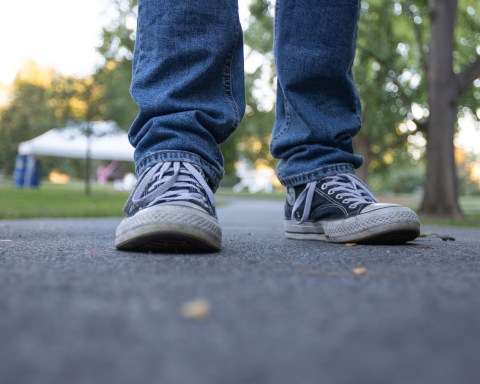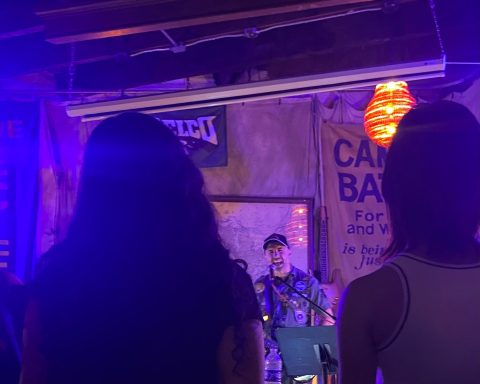Editor’s note: This article was initially published in The Daily Gazette, Swarthmore’s online, daily newspaper founded in Fall 1996. As of Fall 2018, the DG has merged with The Phoenix. See the about page to read more about the DG.
Recently, I made the (moderately) long journey to Bryn Mawr College to view A Century of Self-Expression: Modern American Art in the Collection of John and Joanne Payson, a student-curated exhibit on display in the Class of 1912 Rare Book Room in Canaday Library. While Swarthmore and Haverford have clearly defined and differentiated art gallery spaces, this exhibit is a “pop-up show” of sorts: the room is not usually configured like an art gallery and the walls are temporary installations. Yet it contains an impressive array of American modern art from the collection of a Bryn Mawr alumna and her husband, including works by James Abbott McNeill Whistler, Louise Nevelson, and more.
A Century of Self-Expression is the culmination of a year of collaborative work and study among a group of Bryn Mawr students, Professor of the History of Art Steven Z. Levine, and Curator of Arts and Artifacts Brian Wallace. Known as a 360° cluster, this year-long set of courses titled “Exhibiting the Modern” required students to study the development of modern art and the 1913 Armory Show in New York in the fall of 2013 with Professor Levine. The Armory Show, which is currently celebrating its centennial year, was a landmark exhibition for art and art history that brought American and European modern art to the forefront and established New York as the next capital of the art world. This spring, they worked with Brian Wallace to organize and curate A Century of Self-Expression, including writing the wall text and promoting the exhibit.

The show divides its excellent collection of paintings, drawings, prints and sculpture into several categories: “The Backdrop,” “The Modern City,” “The Nude,” “Leisure Time,” and “Reflections.” The artists on display span from the turn of the 20th century to as recently as 2002, and it’s quite exciting to see how American art has changed during this time period.
While I came into this exhibit knowing and enjoying the works of Whistler, who is represented in this show by his lovely pastel rendering of Venice, the best part of this show was discovering works by an artist I was not previously familiar with. A Century of Self-Expression has on display several works by Paul Cadmus dating from 1991 and drawn in black and white crayon on gray-toned paper. Cadmus’ technique is wonderfully loose and sketchy, with sure movement imbued into every stroke of the crayon. Have Fun, Drive Carefully, designated in the “Reflections” section, depicts a sweet moment between the artist and his lover as the former gets ready to go for a drive, cleverly using the device of the car side mirror to present a divided double portrait. Cadmus’ lover looks both at us, by extension, at Cadmus himself, who is visible in the mirror, bringing us not only into this work but into the intimacy and playfulness of this relationship. Reclining Nude, also by Cadmus, is masterfully rendered, with the titular nude’s right leg and arm seeming to break out of the paper.

Oil on canvas. On loan courtesy of Mr. and Mrs. John W. and Joanne D. Payson.
Other highlights of the exhibit include the affecting Clown with White Tie (located in “Reflections”) by Walt Kuhn and Yvonne Jacquette’s enchanting George Washington Bridge at Night (designated in “The Modern City”). The former is a 1946 oil on canvas of a man in white face paint, shrouded in darkness, glowering at the viewer, creating a dichotomy between the man’s profession (being happy and cheerful for money) and his true feelings about the nature of his work. The sadness in his red-rimmed eyes and the grim resignation of his mouth provokes a sense of sympathy for all those who are unhappy, who feel that they must put on a happy face despite the pain that they suffer and work jobs that they don’t want in order to survive.
The latter is a pastel work that captures the shifting pattern of bright lights on the George Washington bridge with short colorful strokes, creating a sense of joy and wonder in something as banal as the evening commute. The swirling forms stir up excitement and anticipation, demonstrating what must be the artist’s appreciation for the city that never sleeps.
The amount of work that has gone into this show is a marvel to behold. Each work has a dedicated wall blurb with well-written and researched text. However, the organization of the works, while well-intentioned, is slightly murky and at times seemingly arbitrary. For example, several of the works that have been allotted to the “Backdrop” section seem like they would belong just as well in the section dedicated to the nude. Arthur B. Davies’ Untitled (Nudes in the Woods), dating from c. 1910, seems equally dedicated to both the form of the frolicking women and the lush greenery they are set in. Conversely, Rockwell Kent’s 1926 Moonlit Landscape, which has been placed in the nude section, seems like it would be a better fit in the landscape section: the sleeping nude form is compositionally subjugated by the blue-purple mountains and bright white moonlight of his setting.
Had the curators of the exhibit chosen to highlight on this aspect as a purposeful comment on the mixing of genres, it would have been more successful. Instead, the choice to limit “The Backdrop” to works specifically from the 1913 International Exhibition of Modern Art results in a wishy-washy curatorial classification overall.

George Washington Bridge at Night, 1988. Pastel on paper. On loan courtesy of Joanne D. Payson
Despite some organizational hiccups, A Century of Self-Expression is a strong effort by deeply interested and hardworking students. For Swatties interested in modern art or in curatorial practice, it’s definitely worth the trip on the shuttle.
A Century of Self-Expression runs until June 1, 2014. The gallery is open from 12-4:30 PM Monday-Sunday and is open until 7 PM on Wednesday when classes are in session.
Art, Museums, and the Academy
Thursday, March 20, 7:00 pm, Bryn Mawr College Carpenter Library B21
Making Museum Men: Harvard’s Fogg Art Museum between the World Wars
Lecture by Andrew McClellan, Tufts University, followed by a reception
Artist, Scholar, and Student Voices
Friday, March 28, 6:00 pm, Bryn Mawr College Thomas Hall 224
Artist talk and reception with painter Yvonne Jacquette
Saturday, March 29, 9:30am, Bryn Mawr College Thomas Hall 110
Breakfast and presentation by Armory Show scholar Laurette McCarthy
and 360° course cluster students
Meet the Filmmakers
Monday, May 5, 7:00 pm, Bryn Mawr Film Institute (Lancaster Avenue, Bryn Mawr, PA)
The Great Confusion: the 1913 Armory Show
Community screening, Q & A, and reception with Michael Maglaras and Terri Templeton















